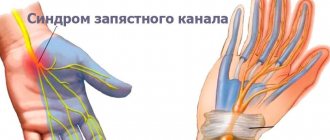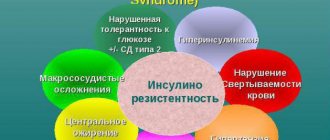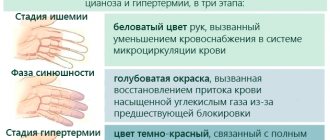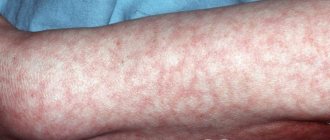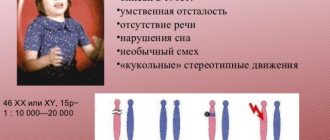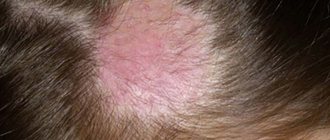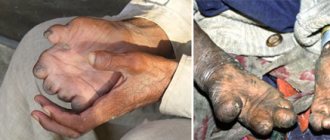Itsenko-Cushing syndrome is a combination of a complex of pathological changes resulting from such a very dangerous disease as hypercorcytism. The development of hypercorcytism is provoked by disruption of the adrenal cortex and, accordingly, the release of large amounts of the hormone cortisol, or in the case of long-term use of drugs containing glucocorticosteroids.
In addition to Itsenko-Kushinka syndrome, there is also a disease with the same name, but these two pathologies are not the same thing. Itsenko-Kushinka disease develops as a result of various disturbances in the functioning of the hypothalamic-pituitary system.
Glucocorticosteroids are steroid hormones that are synthesized in the adrenal cortex and are essential for the normal functioning of the human body. Hormones of this group not only take an active part in metabolism, but are also responsible for performing a huge number of physiological functions.
Adrenocorticotropic hormone (ACTH) is responsible for the functioning of the paired endocrine glands located above the upper part of the kidneys, which promotes the synthesis of hormones such as corticosterone and cortisol. The pituitary gland is controlled by hormones produced by the hypothalamus - liberins and statins. Thanks to this, the human body is able to function as one whole, but the failure of one link can lead to enormous discord in the entire system and provoke an increase in the production of various hormones, and especially glucocorticoids. As a result of this pathology, Itsenko-Cushing syndrome begins to actively develop.
Based on the results of statistical data, we can conclude that this pathology most often occurs in representatives of the fair half of the population than in men. The age category of patients in whom the disease is often diagnosed is 25–40 years.
What role does cortisol play in the body?
When secreted normally, cortisol helps control vital processes in the body. Its tasks include controlling blood pressure, which makes it possible to maintain a normal state of the cardiovascular system; it also increases the level of glucose in the blood, thus balancing the effect of insulin, reduces the inflammatory response of the immune system, and regulates protein, carbohydrate and fat metabolism. One of cortisol's primary jobs is to help the body respond to stress. Because of this, pregnant women in their last trimester and professional athletes typically have elevated cortisol levels. People suffering from alcoholism, depression, panic disorders and malnutrition also have high levels of cortisol in the blood.
Hypersecretion of cortisol, which reaches the borders of hypercorticism and ends in the development of Itsenko-Cushing syndrome, is, as a rule, iatrogenic in nature. This syndrome is named after the authors who first understood and described the reason for the development of this complex of symptoms.
Description of the syndrome
As mentioned above, Cushing's syndrome is characterized by excessive activity of the adrenal glands, as a result of which the body is oversaturated with cortisol. This process is made possible by the control of the pituitary gland, which, in turn, produces adrenocorticotropic hormone. And the activity of the pituitary gland is influenced by the hypothalamus, which produces liberins and statins. It turns out to be a kind of chain, the violation of which in any of its links becomes the cause of increased secretion of the adrenal cortex. In connection with all this, Itsenko-Cushing syndrome develops.
Excessive amounts of cortisol in the body provokes the breakdown and breakdown of protein compounds. Because of this, many tissues and structures undergo negative changes. The bones, skin, muscles and internal organs are primarily affected. The further the decay process goes, the more clearly the processes of dystrophy and atrophy appear in the body. The metabolism of fats and carbohydrates is also affected.
Women of reproductive age between 25 and 40 years of age are much more likely to experience symptoms of Cushing's syndrome.
Causes and mechanism of development of Itsenko-Cushing syndrome
There are many etiological factors that provoke the development of this syndrome. Based on the mechanism of development of hypercorticism, three types are distinguished: endogenous, exogenous and pseudo-Cushing's syndrome.
As already stated, the basis of pathological changes in the development of Itsenko-Cushing syndrome is the hyperproduction of cortisol. An increased amount of cortisol has a destructive effect on most tissues and structural units of the body (internal organs, skin, muscles, including the myocardium), in which pronounced atrophic and dystrophic changes occur over time. Hypercortisolism counteracts insulin, increasing blood glucose levels, which triggers the development of steroid-induced diabetes. Regarding fatty tissue, hypercortisolism carries out a complex tactics of damage, which is expressed in excessive obesity of some areas and atrophy of others, this is due to the different tolerance of individual fatty areas to glucocorticoids. Cushing's symptom causes electrolyte disturbances (hypernatremia, hypokalemia), which are caused by the effect of excess cortisol on the kidneys. The consequence of these electrolyte changes is the development of arterial hypertension, as well as aggravation of myocardial changes, which leads to arrhythmia and the development of heart failure. An increase in cortisol levels has a detrimental effect on the body's immune system, suppressing its functions and causing a tendency to infections.
Development of the disease in children
Itsenko-Cushing's disease is diagnosed in young patients very rarely. But the severity of the course occupies a leading position among endocrine pathologies. The disease most often affects older children. But we cannot exclude the formation of the process in preschool children.
The pathological process so quickly covers many types of metabolism, so timely diagnosis and therapy must be carried out as soon as possible.
The first sign of the disease in children is obesity. Fat is deposited in the upper torso. The face becomes moon-shaped and the skin color becomes purplish-red. In preschool-age patients, a uniform distribution of subcutaneous fat is observed.
90% of patients are diagnosed with growth retardation. Combined with excess weight, this leads to dehydration. Stunting is characterized by closure of the epiphyseal growth plates.
Children, like adults, begin to grow hair, although true puberty is delayed. In boys, such symptoms are associated with a delay in the development of the testicles and penis, and in girls - in impaired ovarian function, uterine hypoplasia, lack of swelling of the mammary glands and menstruation. Hair growth begins to affect areas of the body such as the back, spine, and limbs.
A characteristic manifestation of Cushing's syndrome is a violation of the trophism of the skin. This symptom is expressed in the formation of stretch bands. They are usually concentrated on the lower abdomen, sides, buttocks, and inner thighs. These stripes can be presented in either singular or plural. Their color is pink and purple. During this process, the skin becomes dry, thin, and very easily injured. Often the child’s body is affected by ulcers, fungi, and furunculosis. The chest, face and back areas have acne. Lichen-like rashes form on the skin of the torso and limbs. Acrocyanosis occurs. The skin on the buttocks area is dry and cold to the touch.
Itsenko-Cushing syndrome in children
Itsenko-Cushing's disease most often manifests itself in children in the form of osteoporosis of the bone skeleton. As a result, there is a decrease in bone mass. They become fragile, so fractures often occur. The lesion is applied to the flat bone and tubular bone. When a fracture occurs, its clinical features are noted: the absence or sharp decrease in pain at the fracture site. During healing, a fairly large and long-lasting callus may form.
Itsenko-Cushing syndrome causes pathological changes in the cardiovascular system in children. This manifests itself in the form of hypertension, electrolyte imbalance and hormonal imbalance. Elevated blood pressure readings in this case are mandatory. This is a persistent and early symptom of the disease. Pressure readings depend on the patient's age. The younger he is, the higher his blood pressure will be. Tachycardia is diagnosed in almost all patients.
Young patients experience neurological and mental disorders. These symptoms are characterized by the following features:
- multifocality;
- abrasion;
- different expression;
- dynamism.
Mental disorders often occur. This condition manifests itself in a depressive mood, agitation, and patients often experience suicidal thoughts. When Cushing's syndrome has achieved stable remission, all these manifestations quickly go away.
Children are often diagnosed with signs of steroid diabetes, which occurs without acidosis.
Symptoms of Itsenko-Cushing syndrome
Symptoms of Itsenko-Cushing syndrome are represented by characteristic changes in the appearance of patients; patients with this pathology have a so-called Cushingoid appearance. The patient's face becomes moon-shaped, 90% of patients are obese. Fat deposits are uneven and localized on the face, neck, chest, abdomen and back. The face acquires a purplish-red color, in some cases with a cyanotic tint; this phenomenon is called “matronism.” Even in the absence of obesity in severely ill patients, a characteristic redistribution of subcutaneous fat occurs.
Symptoms
The symptoms that are characteristic of Itsenko-Cushing syndrome are very diverse. The most common signs indicating the presence of this pathology are the following changes, namely:
- Almost all patients suffer from excess body weight. The most common places for fat deposits are the upper half of the body (neck, face, stomach, back). The lower limbs in such patients remain unchanged and are very noticeable for their thinness relative to the proportions of the body. In medical practice, this distribution of fat, which occurs according to a certain type, is called Cushingoid.
- The person's face is very rounded and in appearance is very similar to the moon. The natural complexion changes and becomes purplish-red with a cyanotic tint.
- Very often people develop such an extremely unpleasant and unnatural defect - a buffalo or bison hump on the neck.
- The skin on the outside of the palm becomes very thin and transparent.
- The progression of the disease leads to gradual muscle atrophy, and as a result of this, the development of myopathy occurs.
- “Sloping buttocks” and “frog belly” are signs that are also characteristic of this pathology. The muscles of the buttocks and thighs lose a lot of volume, and the sagging of the abdomen occurs as a result of increased weakness of the abdominal muscles.
- With the syndrome, a hernia of the white line of the abdomen very often develops.
- The skin acquires a marbled color, and the vessels on it become more and more noticeable. Due to the increased dryness of the dermis, constant peeling occurs in certain areas.
- The glands responsible for sweat production begin to function more and more actively.
- On the body of people with this phenomenon, bruises appear even with the slightest damage. This is due to increased capillary fragility.
- Stretch marks appear on the body, which are mainly localized in the shoulders, abdomen, chest, thighs and buttocks. The size of striae can be varied and in some cases reach 80 mm in length and 20 mm in width.
- Acne and spider veins appear on the skin.
- One of the very common companions of this syndrome is. The bones of such people become thin and very susceptible to fractures and various types of deformations.
- When this pathology occurs in the pediatric population, the children will be significantly shorter than their peers. This is justified by the slow development of epiphyseal cartilage.
- Cardiomyopathy in combination with arrhythmia, heart failure, and arterial hypertension can lead to death.
- Patients with this diagnosis are often inhibited and suffer from depression and psychosis. In addition, they are prone to suicide.
- The predominance of nighttime diuresis over daytime, as well as an increase in the amount of urine, leads to the development of peripheral edema and the development of such a constant sensation as thirst.
- In men, this pathology can be accompanied by testicular atrophy, impaired potency and gynecomastia.
- Against the background of constant suppression of immunity, the development of secondary immunodeficiency begins.
- In women, the disease can lead to irregularities in the menstrual cycle, serious problems with conception, and amenorrhea.
Skin changes
Changes in the skin are expressed in marbling of the skin, emphasized vascular pattern, thinning, dryness, peeling, and areas of regional sweating. The combination of skin collagen breakdown and obesity provokes the appearance of stretch marks (striae). Striae are localized on the skin of the abdomen, shoulders, mammary glands, inner thighs, have a purple or purplish-red color and can be several centimeters in size. Often there is an acne-type skin rash and numerous small petechiae. In some cases, hyperpigmentation is observed in areas of friction.
Now let's move on.
How to determine?
Let's go to the doctor. First, see a therapist, then he gives a referral to an endocrinologist. In turn, the endocrinologist prescribes an examination:
- Blood and urine tests (general and biochemistry);
- MRI (magnetic resonance imaging) of the brain;
- MRI and CT (computed tomography) of the abdominal organs;
- CT scan of the chest;
- Hormonal tests, specific blood tests for hormones.
And then, when the diagnosis is established, treatment is prescribed.
Other characteristic symptoms
Itsenko-Cushing syndrome in 10-20% of cases is accompanied by steroid diabetes mellitus, which has no connection with pancreatic diseases. This type of diabetes has a fairly mild course and can be eliminated with the help of a special diet and glucose-lowering medications.
In some cases, peripheral edema develops, as well as poly- and nocturia.
With prolonged hypercortisolism, men may develop:
- signs of feminization;
- decreased libido and potency;
- testicular atrophy;
- gynecomastia.
In women, hyperandrogenism can provoke:
- virilization;
- hypertrichosis;
- hirsutism;
- amenorrhea;
- menstrual irregularities;
- infertility.
How does the disease manifest itself?
Symptoms of Itsenko-Cushing syndrome
Cushing's syndrome manifests itself differently in each patient. The reason is that the body of a certain person reacts in its own way to this pathological process. The following are the most common symptoms:
- weight gain;
- weakness, fatigue;
- excessive hair growth;
- osteoporosis.
Weight gain
Very often, the symptoms of Cushing's disease manifest themselves in rapid weight gain. This prognosis is observed in 90% of patients. In this case, fatty layers are deposited on the stomach, face, and neck. Arms and legs, on the contrary, become thin.
Muscle atrophy is noticeable in the shoulders and legs. This process causes symptoms in the patient associated with general weakness and fatigue. In combination with obesity, this manifestation of the disease causes significant difficulties for the patient during physical activity. In certain situations, a person may experience pain if he stands up or squats.
Thinning skin
A similar symptom with Cushing's syndrome occurs quite often. The skin acquires a marbled tint, excessive dryness and has areas of local hyperhidrosis. The patient has cyanosis, and cuts and wounds take a very long time to heal.
Excessive hair formation
Such symptoms often occur in a woman who is diagnosed with Cushing's disease. Hairs begin to form on the chest, upper lip and chin. The reason for this condition is the accelerated production of male hormones – androgens – by the adrenal glands. In addition to this symptom, women experience menstrual irregularities, and men experience impotence and decreased libido.
Osteoporosis
Osteoporosis
This pathology is diagnosed in 90% of cases in patients with Cushing's syndrome. Osteoporosis manifests itself as a pain syndrome that affects bones and joints. The formation of spontaneous fractures of ribs and limbs is possible. If Itsenko-Cushing's disease affects a child's body, then there is a noticeable lag in the child's growth development.
Cardiomyopathy
With Cushing's syndrome, this condition affects the patient very often. Cardiomyopathy occurs, usually of a mixed type. Its formation is affected by arterial hypertension, electrolyte imbalances or the catabolic effects of steroids. A person experiences the following symptoms:
- disturbance of heart rhythm;
- high blood pressure;
- heart failure.
In addition to the symptoms presented, Cushing's syndrome can cause pathologies such as diabetes. It is determined in 10–20% of cases. You can regulate blood sugar levels with the help of special medications.
Regarding the nervous system, the following manifestations occur:
- lethargy;
- depression;
- euphoria;
- poor sleep;
- steroid psychosis.
Diagnosis of Itsenko-Cushing syndrome
If there is a suspicion of Itsenko-Cushing syndrome, and such suspicions arise after examining the patient and determining typical changes in appearance, a series of clinical and biochemical analyzes of blood and urine samples is indicated. In order to find the root cause of this pathology, the patient is advised to conduct topographic studies, as well as CT and MRI of certain areas.
An important point in diagnosing the Itsenko-Cushing symptom complex is the exclusion of exogenous intake of glucocorticoids (including intra-articular and inhaled).
To confirm this disease, the following tests must be performed:
- determination of the level of cortisol excretion in daily urine: the presence of an increase in excreted cortisol by 3-4 times compared to the norm confirms the reliability of the diagnosis of Itsenko-Cushing syndrome;
- conducting a small dexamethasone test, the essence of which is to determine the level of cortisol after taking dexamethasone. To carry out this test, the patient first needs to determine the cortisol level on the first day at 8-9 am, then at 24 o'clock on the same day take a dose of dexamethasone, and the next day at 8-9 am the cortisol level is determined again. Normally, taking dexamethasone helps reduce cortisol levels by more than half; in patients with Cushing's syndrome, this reaction does not occur.
Studies of biochemical parameters of urine in the Itsenko-Cushing symptom complex determine an increased level of 11-hydroxyketosteroids (11-OX) and a decrease in the level of 17-hydroxyketosteroids (17-OX). There is hypokalemia in the blood, an increase in the level of red blood cells, cholesterol and hemoglobin. Also, laboratory tests can show the presence of complications (steroid-induced diabetes mellitus, electrolyte shifts).
To determine the location of the root cause, the patient is advised to undergo CT, MRI of the pituitary gland, adrenal glands and adrenal scintiography.
In order to identify complications of hypercorticism (rib fractures, vertebrae due to osteoporosis), an X-ray examination or CT scan of the vertebrae and chest is performed.
Prognosis of Cushing's syndrome
In the absence of necessary and timely treatment, the probability of death is 40-50% of all cases of Cushing's syndrome. This occurs due to irreversible changes in the patient's body.
If there are malignant neoplasms in Cushing's syndrome that cause this condition, then the prognosis cannot be encouraging. Only in 20-25% of cases, after surgery and appropriate postoperative treatment, a more or less positive result is possible.
If the tumor in Cushing's syndrome was benign in nature, then after its surgical excision, positive dynamics are observed in almost 100% of cases.
Complications of Itsenko-Cushing syndrome
Long-term lack of therapy for the chronic course of Itsenko-Cushing syndrome can provoke the death of the patient due to complications such as stroke, cardiac decompensation, sepsis, chronic renal failure, severe pyelonephritis, osteoporosis with the presence of multiple fractures of the spine and ribs.
Reduced resistance to infections with hypercortisolism often becomes a predisposing factor to the development of phlegmon, furunculosis, fungal and suppurative skin lesions.
With Itsenko-Cushing syndrome, an emergency state of adrenal (adrenal) crisis may develop, which manifests itself in the form of arterial hypotension, nausea, vomiting, impaired consciousness, abdominal pain, hypercalcemia, hypoglycemia and metabolic acidosis.
As a rule, urolithiasis in hypercortisolism is associated with osteoporosis and hypersecretion of phosphate and calcium in the urine, which contribute to the formation of phosphate and oxalate kidney stones.
Itsenko-Cushing syndrome during pregnancy can cause miscarriage or complicated childbirth.
Complications of Cushing's syndrome
Complications of Cushing's syndrome symptoms in women:
- transition of the process and symptoms into a chronic form. Without qualified medical treatment in a woman, the symptoms of Cushing's syndrome are often fatal. The chronic process is fraught with strokes, heart failure, and serious disorders in the spine.
- An adrenal or adrenaline crisis is manifested by symptoms such as vomiting and abdominal pain, low blood sugar, high blood pressure and confusion.
- fungal formations, boils and phlegmon, various processes of a purulent nature - all this may be due to a decrease in the body’s resistance to various types of infections.
- symptoms of urolithiasis in a woman due to increased excretion of calcium and phosphates from the body along with urine.
Treatment of Itsenko-Cushing syndrome
The treatment strategy for the iatrogenic (drug) form of Itsenko-Cushing syndrome consists of gradually withdrawing glucocorticoids and prescribing other immunosuppressants instead.
The presence of the endogenous nature of hypercortisolism syndrome implies treatment with drugs that suppress steroidogenesis (chloditan, mitotane, ketoconazole, aminoglutethimide).
If a tumor of the pituitary adrenal gland is diagnosed, surgical treatment is advisable; if it is impossible to remove the tumor, unilateral or bilateral adrenalectomy (removal of the adrenal glands) is performed or a course of radiation therapy of the hypothalamic-pituitary region is performed. To enhance the effect and minimize relapses, radiation therapy is often carried out in combination with drug and surgical treatment. If a pituitary adenoma is not visualized in patients with Cushing's syndrome, the use of proton therapy in the pituitary region is indicated.
In addition to basic therapeutic measures, patients with Itsenko-Cushing syndrome are prescribed symptomatic treatment. Symptomatic therapy consists of prescribing diuretics, antihypertensives, hypoglycemic drugs, bistimulants, immunomodulators, cardiac glycosides, sedatives or antidepressants, drug therapy for osteoporosis, and vitamin therapy.
The principle of postoperative treatment of patients with chronic adrenal insufficiency who have undergone surgery to remove the adrenal glands is lifelong hormone replacement therapy.
Pregnancy with Cushing's syndrome
The prognosis for pregnancy in combination with such symptoms is extremely unfavorable.
Very often, pregnancy spontaneously ends in the very early stages or birth occurs prematurely. The fetus is severely delayed in development, which is why its death is possible during this period. Miscarriage is associated with adrenal insufficiency in the embryo due to the same pathology in the mother.
It is safe to call pregnancy a factor in the development of complications of the symptoms of this syndrome in a woman. This is so dangerous that there may be an immediate threat to the patient’s life.
If, nevertheless, the pregnancy proceeds according to the norms, it is very important to constantly be monitored by specialists and receive courses of symptomatic therapy to maintain the condition of the expectant mother.
Degrees of Cushing's disease
There are no forms, stages or types of the syndrome; Cushing's disease is divided into three degrees of clinical course. The degrees are:
- mild degree is characterized by moderately severe symptoms: osteoporosis may be absent, menstrual function is preserved;
- the average degree has pronounced symptoms, but there are no complications;
- in severe cases, complications develop: muscle atrophy;
- hypokalemia – low density of potassium ions in the blood;
- hypertensive nephropathy – damage to small renal arteries due to arterial hypertension;
- severe mental disorders are a group of diseases characterized by complications of their course and therapy.
In addition to degrees, there are two courses of Itsenko-Cushing's disease:
- progressive. Characterized by a rapid (within 7 months) increase in symptoms and complications;
- torpid. Pathological changes gradually develop over 10 years.
Preventive measures
Prevention of diseases of the endocrine system, in particular Cushing's disease, consists of following a proper diet, diets prescribed by a doctor, limiting serous physical activity and emotional stress. In order to detect the problem in time and begin to deal with it effectively, you need to undergo a full examination from time to time. Rare diseases such as Cushing's disease are very dangerous to health, and the sooner treatment is started, the greater the patient's chances of returning to a normal lifestyle.
Diagnostics
When diagnosing the disease, a number of screening tests are used:
- Urine examination. Daily cortisol excretion.
- Dexamethasone test (small). Detection of cortisol in blood serum in stages - before and after the use of dexamethasone.
- Dexamethasone test (large). It differs from the previous method only in the dosage of the drug.
- MRI (necessary to calculate pituitary adenoma).
- MRI (or CT) of the adrenal glands.
- Spinal radiography. Thanks to it, it is possible to diagnose the expected complications of the syndrome. In particular, compression fractures are detected.
- Biochemical research. Necessary for the diagnosis of diabetes mellitus (steroid) and electrolyte disorders.
Alternative Treatments
In addition to drug therapy and surgery, some alternative methods of treating the syndrome and treating Cushing's disease can be used. These include:
- nutrition;
- treatment with folk remedies;
- physical exercise.
Nutrition
With Cushing's syndrome, the level of corticosteroid hormones in the blood increases, causing obvious changes in the functioning of various tissues and organs. Diet will not greatly affect the production of cortisol and other hormones, but proper nutrition should not be underestimated. Strict adherence to a diet will help normalize and regulate metabolism.
The diet should not contain a lot of saturated fatty acids ( margarine, mayonnaise, butter ); instead, it is worth increasing foods containing vitamin D ( eggs, hard cheese, dairy products ). You also need food containing calcium ( cottage cheese, milk, sesame seeds, greens ).
If you are obese, it is better to reduce your intake of salt, animal fats and liquids . Strong tea, alcoholic drinks and coffee should be completely eliminated and replaced with light soups, boiled meat, and cereals. For steroid-induced diabetes, it is recommended to consume more proteins and reduce the proportion of carbohydrates and fats .
Folk remedies
For auxiliary therapy of Cushing's syndrome, treatment with folk remedies is used. Before turning to traditional medicine, you need to know everything about pathology: what it is, causes, factors and what complications there may be. The means include:
- Sea buckthorn juice. Take 50 ml in pure form 1 hour before meals three times a day. The enveloping property protects the gastric mucosa from the effects of gastric juice and eliminates the symptoms of peptic ulcer;
- Linden honey. Dissolve 1 tablespoon of the product in a glass of warm water and drink three glasses throughout the day;
- Garlic infusion. Useful for steroid diabetes, the drug helps reduce sugar levels. You need to finely grate the garlic cloves, pour boiling water over them and leave to steep for 30 minutes. Drink half a glass three times a day in small sips;
- Infusion of rowan fruits. Pour a tablespoon of dried fruit into a glass of boiling water. Leave to infuse, then drink half a glass three times a day.
Exercises
Exercise is beneficial for Cushing's syndrome and disease. It is recommended to regularly perform light physical activity, it helps relieve stress, lose excess weight and increase the correct amount of muscle mass. The most effective way is yoga , which balances metabolism, immunity and hormone levels.
Causes
The primary causes of Itsenko-Cushing syndrome are overproduction of adrenocorticotropic hormone and suddenly formed corticotrophic pituitary adenomas. This leads to obvious endocrine and hypothalamic disturbances. The main causes of the syndrome include:
- Pituitary microadenoma is a benign glandular formation not exceeding 10 mm in size. The tumor causes an increase in the level of adrenocorticotropic hormone in the body. According to endocrinologists, this is the main reason for the development of the syndrome. Pathological symptoms appear in 83% of cases;
- Adrenal cortical adenomatosis, adenocarcinoma and adenomas lead to the progression of the syndrome and Cushing's disease in 19%. Tumor growths lead to disruption of the normal structure and functioning of the adrenal cortex;
- Corticotropinoma of the lungs, thyroid, prostate, pancreas, ovaries and other organs. Due to the tumor, a pathological syndrome develops in 2% of all cases. Corticotropinoma produces corticotropic hormone, which causes hypercortisolism;
- Disturbed process of secretion of biologically active components;
- Due to excessive production of cortisol, a catabolic effect occurs, that is, the protein structures of muscles, skin, bones, internal organs, etc., break down. Gradually, this condition leads to atrophy and tissue degeneration;
- Increased absorption of glucose by the intestine causes the occurrence of a steroid form of diabetes;
- Violation of fat metabolism. This condition is characterized by excessive fat deposition in certain areas of the body and wasting in others, due to different susceptibility to glucocorticoids;
- Too high a cortisol level affects the kidneys, resulting in electrolyte disorders (hypernatremia and hypokalemia), increased blood pressure and disruption of degeneration processes in muscle tissue;
- Long-term use of drugs that contain glucocorticoids or adrenocorticotropic hormone.
Heart failure, cardiomyopathy and arrhythmia develop due to hypercortisolism affecting the heart muscle. Cortisol suppresses the immune system, so Cushing's syndrome in children provokes the occurrence of various infectious diseases.
Provoking factors for the occurrence of Itsenko-Cushing syndrome
Any pathology in the glands can change a person’s appearance, inhibit reproductive function, and have a negative impact on the condition of blood vessels and the heart. Therefore, experts are especially carefully examining new information about the pathogenesis, causes and provoking factors of Itsenko-Cushing syndrome. Factors leading to the occurrence of the syndrome are:
- inflammatory process in the arachnoid mater. Accompanied by the formation of adhesions (arachnoid);
- traumatic brain injuries, concussions;
- encephalitis - inflammation of brain structures caused by pathogenic microorganisms or mite activity;
- meningitis - inflammation of the membranes of the brain and spinal cord;
- heredity;
- severe intoxication of the body;
- damage to the central nervous system.
Cushing's syndrome can have a progressive course with the manifestation of all symptoms within a year, or a gradual course with an increase in symptoms from 2 to 10 years.
What kind of disease is this?
Itsenko-Cushing's disease is a neuroendocrine disease characterized by increased production of adrenal hormones.
The pituitary gland produces excess ACTH (adrenocorticotropic hormone), which is responsible for the functioning of the adrenal glands. Such failures cause an increase in the size of the adrenal glands, and they, in turn, increase the production of corticosteroid hormones, which ultimately provokes the development of a pathological condition.
The symptoms of the disease were described by Harvey Cushing (neurosurgeon from America) and Nikolai Itsenko (neurologist from Ukraine). Hence the name of the disease. Today, all their notes are supported by facts.
The disease manifests itself due to malfunctions in the hypothalamic-pituitary system. Itsenko believed that all failures occur in the hypothalamus, which is responsible for the coordinated functioning of the endocrine and nervous systems. But the American said that all these are consequences of the development of a neoplasm that affected the pituitary gland.
When Cushing's disease develops, its first sign is hormonal imbalance. They begin with the hypothalamus receiving nerve impulses of unknown origin, after which the cells begin to intensively produce substances that release adrenocorticotropic hormone in the pituitary gland.
The pituitary gland, reacting to such stimulation, releases excess ACTH into the blood, which negatively affects the functions of the adrenal glands, and disruptions in metabolic processes occur.
The pathology is more often diagnosed in women than in men. The most dangerous age is 20-40 years, but it can occur in the elderly, children, and adolescents during puberty.
Main symptoms and signs
The appearance of both the patient with damage to the pituitary gland and the person whose medical history tells of a malignant tumor of the adrenal cortex is almost the same. The signs mainly indicate the harmful effects of elevated hormone levels, but cannot suggest anything about the source. The most characteristic symptoms are the following:
- A special form of obesity: there is a lot of it on the chest, abdomen, face and neck, and thin arms and legs.
- The face is moon-shaped, with an unnatural “hobbit” blush, often purple-bluish, the same coloring of the back.
- People with hypercortisolism have atrophy of the muscles of the legs and shoulder girdle, abdomen, so the arms and legs are thin, it is difficult for patients to stand up and squat, and the stomach looks like a frog. Muscle weakness leads to frequent hernias.
- Dry, flaky skin is extremely characteristic; its vascular pattern is “conspicuous” in the form of marbling, impaired sebum secretion, acne and hyperpigmentation. The release of pigment increases where the skin is subject to abrasion: on the collar, elbows, stomach (in the projection of the belt).
- Purple stripes - stretch marks - up to a purple tint on the stomach, hips, and shoulders are definitely noticeable.
- The main symptoms of severe illness and syndrome include osteoporosis (pathological fractures of the vertebrae, femoral neck).
- Electrolyte changes in the blood plasma lead to cardiomyopathy, which manifests itself as severe rhythm disturbances and arterial hypertension develops.
- A symptom such as concomitant “steroid diabetes” with hyperglycemia develops.
- Since androgens (testosterone) are also secreted with corticosteroids, women experience hirsutism (male hair growth), menstruation is inhibited with the development of amenorrhea. But in men, sexual function also does not improve: impotence and decreased libido occur.
To these severe symptoms can be added a pronounced decrease in immunity: purulent processes occur, wound healing decreases, and trophic ulcers appear. Patients experience constant weakness and malaise, autonomic disorders and depression or, on the contrary, euphoria.
About diagnostics
To diagnose both of these conditions and separate them from each other, an examination is carried out, which begins with a small dexamethasone test. The patient is given dexamethasone according to a special regimen, and then the blood is tested. A healthy person will have a decrease in plasma cortisol levels, but a patient will not.
This suggests that the patient has one of the variants of hypercortisolism syndrome. Then a larger sample is carried out. This method makes it possible to distinguish Cushing's disease from secondary hypercortisolism. These samples differ in dosage - with a larger sample the dose is higher. If cortisol in a blood test decreases after the administration of dexamethasone, then the pituitary gland is to blame, and if not, then the adrenal glands.
Then topical diagnostics are carried out: MRI determines the pituitary adenoma in Cushing's disease, tomography of the adrenal glands and lungs is carried out in search of ectopic foci. The diagnosis is final if not only the source of hormone synthesis is identified, but also concomitant diagnoses are made (steroid diabetes, osteoporosis), etc.
Classification
In medicine, it is customary to classify this disease according to its course and form. The form can be light, medium and severe. Moderate expression of symptoms is characteristic of a mild form of Itsenko-Cushing's disease. In this case, the disease may have little effect on the menstrual cycle. In the moderate form, all symptoms are clearly expressed, and the severe form is also accompanied by complications, which include mental disorders, muscle weakness, kidney hypertension, and muscle atrophy.
The course of this disease of the endocrine system can be torpid or progressive. In the first case, the pathology develops gradually, in the second - quickly, over several months.
Respiratory and digestive organs
The human endocrine system works closely with other organs, so diseases that develop in it negatively affect the condition of the entire body. It is possible to diagnose pneumonia, bronchitis and tuberculosis. The reason for their development is a decrease in the body’s reactivity and problems associated with carbohydrate metabolism disorders.
Itsenko-Cushing's disease provokes the occurrence of diseases of the digestive system. This is chronic gastritis, frequent painful attacks in the epigastric region, heartburn. Sometimes gastroduodenal ulcers or gastric bleeding occur. The cholesterol-esterifying, galactose-fixing, synthetic and antitoxic functions of the liver are disrupted.
Treatment
Treatment of Cushing's syndrome is carried out after determining the causes of the disease; blockers of ACTH synthesis and symptomatic therapy aimed at reducing metabolic disorders may be prescribed. Symptomatic therapy for Itsenko Cushing's syndrome includes the following:
- antihypertensive drugs;
- antidiabetic agents;
- cardiovascular drugs;
- immunomodulators;
- diuretics;
- sedatives;
- vitamins
Diet and proper nutrition play an important role in the treatment of such patients.
If tumors of the adrenal glands, pituitary gland, or hypothalamus are detected, surgical treatment is resorted to whenever possible. An operation for Cushing's syndrome, in which the adrenal gland is removed from one or both sides, is called adrenalectomy. After surgical removal of the adrenal glands, hormone replacement therapy is required.
When tumors are detected in the area of the pituitary gland and hypothalamus, radiation therapy methods are used, which are combined with surgery.
Diagnosis and diagnosis
Differential diagnosis of Itsenko-Cushing's disease and Cushing's syndrome is carried out using a test with dexamethasone and metopyrone. During the day before taking metopyrone, urine is collected from the patient in order to determine the content of 17-OX. Then, for two days, metapyrone is taken orally every 2 hours. It has the ability to selectively block the enzyme 11-P (hydroxylase) in the adrenal cortex. As a result, the biosynthesis of corticosterone, aldosterone and cortisol is gradually disrupted. A decrease in the level of cortisol in the blood leads to an increase in the secretion of ACTH. Taking metopyrone activates the hypothalamic-pituitary system, resulting in increased excretion of 17-OX in the urine.
Itsenko-Cushing's disease can be diagnosed by examination. The presence of the disease is indicated by the localization of fat, atrophic buttocks, thin limbs, stretch marks of a reddish-violet hue on the skin of the mammary glands, thighs, abdomen, shoulders, high diastolic and systolic blood pressure. Additional methods may also be used.
Itsenko-Cushing's disease: causes
The prerequisites for pathology are quite difficult to identify. But experts managed to systematize the main reasons that can provoke a deviation:
- injuries in the skull area;
- infections affecting the brain;
- long-term mental disorders;
- pituitary adenoma (its anterior part);
- hormonal changes in the body;
- intoxication.
Any of the above factors can become an impetus for a failure in coordinated work: hypothalamus - pituitary gland - adrenal glands.
In this case the following are noted:
- disorders in the body of fat metabolism;
- disruptions in the functioning of the ovaries;
- signs of osteoporosis;
- arterial hypertension.
In the presence of these disorders, the activity of the adrenal glands increases, they produce an excess amount of hormones, which affects metabolism (protein and carbohydrate).
Forecast
The prognosis depends on the nature of the tumor - benign or malignant. If a patient has a benign corticosteroma, then the subsequent prognosis is positive, but the functioning of a healthy adrenal gland tends to be fully restored in only 85% of patients. In general, the prognosis depends on the causes, presence, severity of exacerbations, timely diagnosis and treatment. Patients should be under the supervision of an endocrinologist. Disease and syndrome are not the same thing, so experts take into account all the differences between causes and symptoms.
